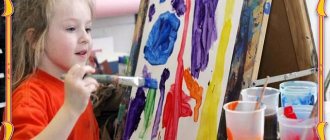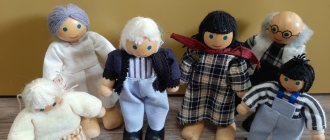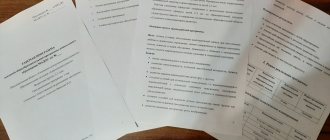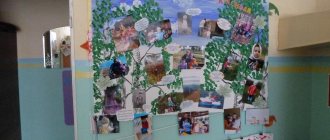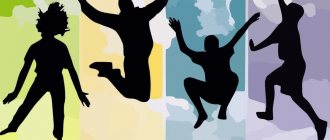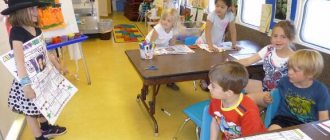Individualization of educational activities in preschool organizations
We often think about what our student should be like. We want the child to be healthy, friendly and responsive, independent, proactive, inquisitive, confident in his abilities, and able to set goals for himself. If we compare these qualities with the portrait of a preschool graduate in the context of the Federal State Educational Standard, we will see obvious coincidences.
Traditionally, the teacher was obliged to give the child knowledge in accordance with program requirements. Life changes quickly and neither a teacher nor a parent can predict what knowledge a child will need in the future. Hence the need arises to develop the child’s ability to learn and develop throughout his life. This can be done through the individualization of education, which allows taking into account the interests, capabilities and social situation of the development of pupils of a preschool educational organization.
Practice shows that there cannot be two children who learn and develop in exactly the same way - each child acquires and demonstrates his own knowledge, attitude, skills, personality traits, etc. All children, including typically developing children, have individual characteristics that I identify and take into account to ensure that the learning and development process is optimized. By carefully observing students and identifying their interests and strengths, I help children solve problems in ways that suit their individual learning styles. Thus, the individualization of education is based on supporting children in the development of potential capabilities, stimulating the desire of children to independently set goals and achieve them in the process of cognition. My focus is on ensuring that every child actively participates in educational activities.
The traditional approach, which assumes that all children react equally to a certain teaching method, that one should be “like everyone else,” “not show character,” “don’t demand too much,” often turns out to be ineffective in teaching. When working with children, you can hear the following phrase: “Look how Seryozha draws, he does it wrong, not like everyone else.” In this case, I respond positively to the child’s individual characteristics, while demonstrating to the children that accepting others and responding to differences is important and correct. It should be noted that there must be mutual respect between the teacher and the children. Respect is a necessary element in every community. Children, noticing how I show respect for each child in the group, learn to accept all other children - and those who run slowly; and those who draw well; and even children with unusual or challenging behavior. After all, the degree of respect that children feel from other people is a key factor in the development of their self-esteem, which, in turn, lays a strong foundation for positive relationships with other children.
Individualized learning occurs simultaneously on multiple levels. In its broadest sense, individualization can extend to an entire group of children. The group is a unique micro-society with its own unique subculture (favorite activities and games, rules accepted in the group, interests of children, characteristics of interpersonal communication and other characteristics), in which the individualization of learning and development manifests itself spontaneously. Making their own choice of content, partnership, materials, place and method of work, each child acts at his own discretion or in agreement with other members of the microgroup at his own pace, obtaining his own results, including acquiring new knowledge and skills. This is clearly visible when children are offered games of various content. One child chooses the game “Collect a picture”, three or four pupils team up for the game “Mosaic”. It happens that out of the entire group of children, one child will pick up a book and look at it with great interest.
In order for natural individualization to take place, I promptly organize a developmental environment that stimulates the activity of children. If a child experiences any difficulties during independent games, for example, in the game “Build a Pyramid,” I come to the rescue. The child himself feels that something did not work out for him. I encourage, ask questions that lead the child to think. Thus, the student finds a way out of the current situation.
To implement individualization during planning, I determine the elements to ensure it: flexibility in the implementation of activities and careful selection of materials. For example, during sculpting, children plan to sculpt animals. I organize activities in such a way that children have the opportunity to choose: what animal each of them will sculpt; from what material (plasticine of different colors, colored dough, clay, paper pulp). My task is to help those who find it difficult to start work on their own. I help some with words, I encourage others, and I provide physical help to others if they need it. More capable students can make many different animals, as complex as they wish. Next, I can offer my assistance in designing a complete composition. During my work, I ask questions of different directions and complexity, offer different options for performing actions and ideas. Instead of directly telling children what and how they should do, I help them do what the students themselves want. This approach provides a relationship structure through which children can maintain independence and I can respond to their individual wants and needs when necessary. The example of sculpting also illustrates another element of individualization—the careful selection of materials. Most of the materials I use are flexible and have varying degrees of complexity - from the simplest to the most complex. This variability creates optimal opportunities for individualizing education, since the use of materials involves natural individualization.
Individualization can be observed at the subgroup level within one group of children. Any activity independently chosen by the children or organized by the teacher can be performed in small subgroups of four to five children. When the children make a choice, break into small subgroups and independently do what they have chosen, I watch them carefully. During the activities of the pupils, I devote some time to each small subgroup or individual children, providing them with support and assistance if necessary.
Traditionally, the process of education and upbringing was mainly focused on the average level of development of the child, so not every student could fully realize their potential. Today, one of the solutions to this problem is the preparation and implementation of an individual educational route, which helps to reveal the personal potential of the student. When drawing up and implementing an individual educational route, I use both traditional and modern methods and techniques. Through conversations, games, activities, reading fiction, sketches, I introduce various emotions and feelings. I conduct games, exercises and trainings that promote the development of emotional, personal and behavioral spheres (developing communication skills and improving relationships with others, relieving fears and increasing self-confidence, reducing aggression and weakening negative emotions): “Mirilki”, “Morning of joyful meetings” , “Let's smile at each other”, “We'll hold hands” and others. To develop mental processes, I include in an individual educational route such games and exercises as “Cabinets”, “What has disappeared?”, “What has changed?”, “Say it in one word”, “Find the differences”, “Complete the drawing”, “What did you sound? " To effectively implement an individual educational route, I constantly study and identify the level of development of each child, the pace of his progress, look for the reasons for the lag, outline and solve specific tasks that would ensure further development.
Practice has shown that the use of individualization of education maximizes the individual potential of the child, and also qualitatively affects the positive attitude of children to the learning process, increasing the level of performance in the classroom, and the depth and quality of assimilation of program material by each child and the group as a whole. When planning and organizing any activity, the teacher must not forget that the child is the subject of his own development. A modern teacher must work “from the child”, creating conditions for his successful socialization, development of personality and individuality.
Literature
- Vershinina, N.B., Modern approaches to planning educational work in kindergarten. Reference and methodological materials [Text] / N.B. Vershinina, T.I. Sukhanov. -Volgograd: Teacher, 2010. - 111 p.
- Kovalchuk, L.I. Individual approach to raising a child: A manual for kindergarten teachers [Text] / L.I. Kovalchuk.-2nd ed., add. – M.: Education, 1985. – 112 p.
- Lesina, S.V. Individual development of children in preschool educational institutions. Diagnostics, planning, lesson notes [Text] / S.V. Lesina.–2nd ed., stereotypical. – Volgograd: Teacher, 2008. – 237 p.
Consultation - message for teachers “Individualization of education in preschool educational institutions: myth or reality?”
Standard guides
preschool education workers to support the individuality and initiative of children, building the educational process taking into account the individual characteristics, abilities and capabilities of each child.
Individualization of education
is based on supporting children in the development of their potential, stimulating children’s desire to independently set goals and achieve them in the process of learning. The attention of teachers is aimed at ensuring the active participation of the child in the educational process.
The implementation of the principle of individualization in preschool educational institutions is carried out through:
Changing forms of interaction between teacher and child.
Changing the content of educational activities.
Organization of the subject-spatial environment.
Interaction between kindergarten and family.
How is individualization of the educational process achieved?
Individualization is achieved by taking into account the current level of development of each child
and planning appropriate activities to ensure every child has the opportunity to succeed. This requires comprehensive information about the child’s development and his individual characteristics.
What are some personalized learning techniques?
The problem of implementing individualization in a mass educational institution arises: how to achieve the noble goals set for teachers, while simultaneously teaching everyone differently?!
1. The first condition for individualizing educational activities with children is the creation of a developmental environment that would stimulate children’s activity.
A group of children is a unique micro-community with its own unique subculture (favorite activities and games, rules accepted in the group, interests of children and hobbies of adults, characteristics of interpersonal communication and other characteristics) in which the individualization of learning and development manifests itself spontaneously.
Making his own choice (content, partnership, materials, place and method of work), each child acts at his own discretion or in agreement with other members of the microgroup, at his own pace, obtaining his own results, including acquiring new knowledge and skills. Each group is individual and unique. The teacher fills it out, focusing on the individual characteristics of each child and the team as a whole. The main idea for the design of playrooms, bedrooms, and reception areas is that the group should belong to the children, which means it is necessary to reflect their interests. In other words, the group should be saturated with permanent and temporary components of the children's subculture, helping preschoolers to better understand and discover their capabilities and the capabilities of their peers, master social roles and relationships, partnerships, understand the values of the world around them and adapt to the social world.
Individualization in a developing subject-spatial environment in kindergarten
Individualization in a developing subject-spatial environment in kindergarten
In accordance with the Federal Law of December 29, 2012 “On Education in the Russian Federation”, modern preschool education is one level of general education. Rapid changes in society have entailed changes in preschool education; there has been a reorientation from an emphasis on the development of “knowledge, abilities, skills” in preschoolers to the choice of a strategy to support the personal development of each child. Article 64 states “Educational programs of preschool education are aimed at the diversified development of preschool children, taking into account their age and individual characteristics, including the achievement by preschool children of a level of development necessary and sufficient for their successful mastery of educational programs of primary general education, on the basis of individual approach to preschool children and activities specific to preschool children.”
In the general provisions of the Federal State Educational Standard in paragraph 1.4. — the basic principles aimed at developing the individualization of preschool education are revealed:
-building educational activities based on the individual characteristics of each child, in which the child himself becomes active in choosing the content of his education, becomes a subject of education (hereinafter referred to as individualization of preschool education)
-supporting children's initiative in various activities
- age adequacy of preschool education (compliance of conditions, requirements, methods with age and developmental characteristics).
Individualization is the development of characteristics that distinguish a person from the surrounding mass. Individualization is the implementation of the principle of an individual approach, it is the organization of educational activities, taking into account the individual characteristics of pupils, which allows creating optimal conditions for the realization of the potential capabilities of each child.
Individualization is impossible without a specially organized subject-development environment in which the child acts independently. The Federal State Educational Standard for Educational Education makes the following requirements for a developing subject-spatial environment: “A developing subject-spatial environment must be content-rich, transformable, multifunctional, variable, accessible and safe.” RPPS should ensure the possibility of implementing the Program taking into account age and individual capabilities.
In our kindergarten, an internal assessment of the education quality system is carried out, VSOKO includes: monitoring of individual achievements of children, used as a professional tool for the teacher in order to receive feedback from their own pedagogical actions and plan further individual work with children according to the program; 2. monitoring of conditions, which includes: - assessment of psychological and pedagogical conditions; — assessment of the subject-development environment; external public participation, assessment of the quality of implementation of educational programs by parents (legal representatives) of pupils.
In assessing the subject-developmental environment in our preschool educational institution, one of the criteria is individualization.
The names of children in all age groups of our preschool educational institution are written on drawings, booths on chairs; on tables; on the beds. The groups have stands “All about me”, “Hello, I’m here”, “My mood”, “My achievements”. “When I was born”, “My favorite toy”, “Star of the day” (“Star of the week”), “Panorama of good deeds”, “Birthday boy’s corner”, “Palms of success”, “Children say”. There is a box “Business chores” (badges with the child on duty for the day). The information on the stands changes throughout the year. Each group has a designated place for collecting items. Portfolios of children's achievements are maintained.
In order for children to feel emotionally comfortable, in each age group of our kindergarten there are images of families, namely:
— photos, photo albums of each family;
- children's drawings and stories about families;
- things brought by children from home;
— there is a place where children place their things in the group (individual shelves or boxes).
The development of a preschooler’s personality is impossible without the formation in the child of such qualities as confidence and significance. Therefore, in all groups there are photographs of children, portraits, photographs of children engaged in certain activities; information with photographs, achievements.
There are signed children's works (works made on a theme, or spontaneous children's creativity). Educators place children's creative products in both reception and group rooms. Children can independently place their drawings and crafts in specially designated areas. Teachers create individual exhibitions (placed both in the reception area and in the halls of the kindergarten).
One of the main conditions for creating individualization in the RPPS is the active participation of parents. Parents in our kindergarten are our social partners, participants in the educational process in the preschool educational institution. Parents help in creating children's portfolios, help in organizing individual exhibitions, and participate in the creation of family and children's projects. In addition, parents share information about their child and their experience in raising them. Parents also take part in monitoring the child’s individual achievements.
Properly thought out and constructed individualization in a developing subject-spatial environment provides the preschooler with opportunities for self-development and independence, the development of cognitive activity and initiative, and helps to raise a confident, creative personality.
Gultyaeva Irina Aleksandrovna,
senior teacher of MKDOU d/s No. 451
